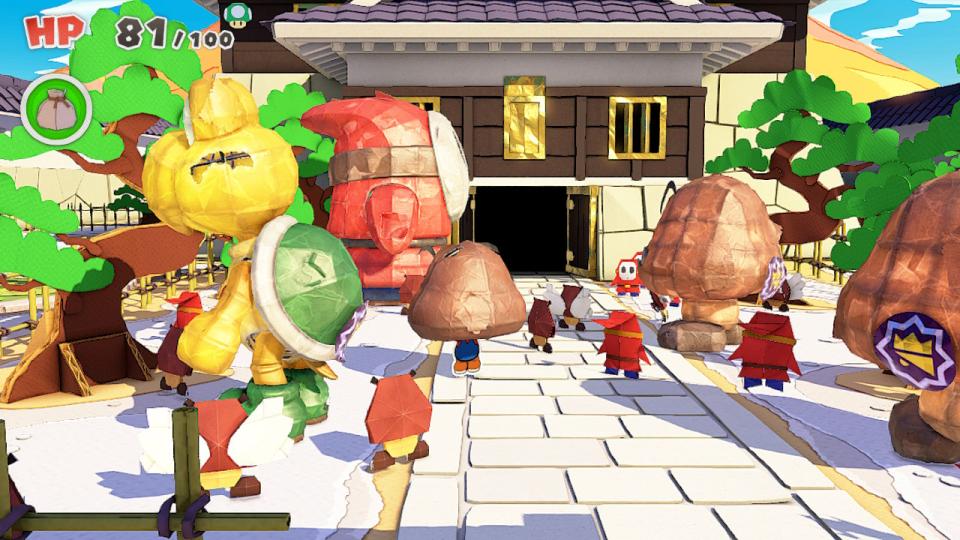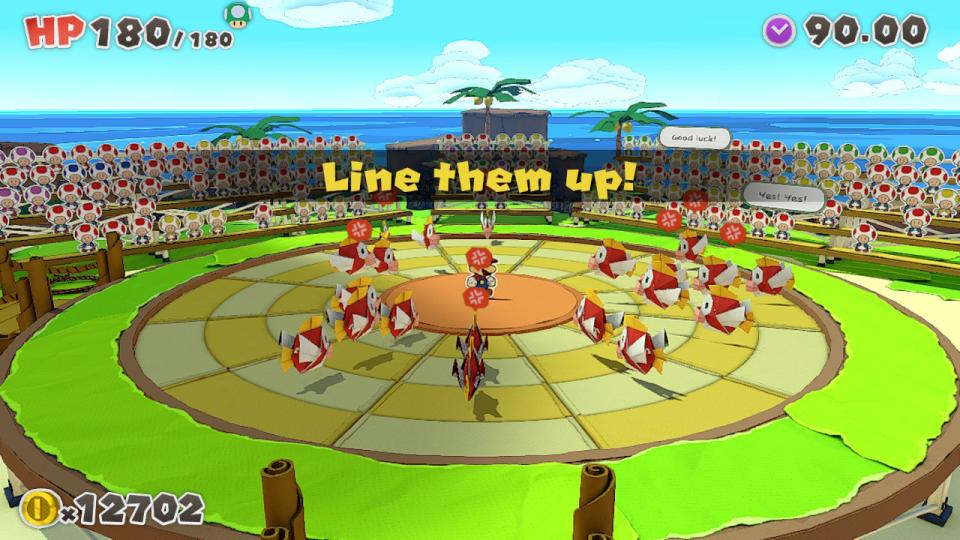Search
[{{{type}}}] {{{reason}}}
{{/data.error.root_cause}}{{{_source.title}}} {{#_source.showPrice}} {{{_source.displayPrice}}} {{/_source.showPrice}}
{{#_source.showLink}} {{/_source.showLink}} {{#_source.showDate}}{{{_source.displayDate}}}
{{/_source.showDate}}{{{_source.description}}}
{{#_source.additionalInfo}}{{#_source.additionalFields}} {{#title}} {{{label}}}: {{{title}}} {{/title}} {{/_source.additionalFields}}
{{/_source.additionalInfo}}Paper Mario: The Origami King (Switch)

Paper Mario: The Origami King
Developed By: Nintendo
Published By: Nintendo
Released: July 17, 2020
Available On: Switch
Genre: RPG
ESRB Rating: E
Number of Players: 1 offline
Price: $59.99
(Amazon Affiliate Link)
The Paper Mario series has gone through a lot of different changes since its N64 roots. While it was a traditional RPG for the first two entries of the series, the “sort of 2D but not really” franchise has seen games with wildly polarizing gameplay mechanics beginning with Super Paper Mario. The sixth game in the franchise, Paper Mario: The Origami King, might not be a gameplay return to form fans were expecting, but its amazing story and presentation more than makes up for that.
Paper Mario: The Origami King tasks Mario on a quest to save the world from being folded up by antagonist Olly, an origami figure who wants to rule for eternity. After barely escaping from the clutches of the prospective king, Mario runs into Olivia, Olly’s sister who wants to stop her brother from exacting his plans. Armed with his boots and hammer, the duo will have to destroy the streamers covering the land as well as thwart the Legion of Stationery, sentient real-life office supplies terrorizing Toads.
The main game revolves (quite literally) around a ring-based combat system. During each battle, enemies are scattered across a board, and Mario needs to rotate or switch the ring’s panels in order to line up enemies, which can then be defeated using attacks or items. Like Sticker Star and Color Splash, attacks are limited-use, but only break if you use them too many times. Attacks are frequently obtained through exploring the overworld or buying them. If you get stuck on a certain layout, you can use coins to either buy more time, or bribe your audience of Toads to help. More coins for either method means more assistance. While the addition of rings is a new concept, the execution can be simple for the first few hours.
The main lineup style consists of most of the combat, though boss fights instead revolve around a path system. The board is still ring-shaped, but in these battles, panels are scattered around the board, which Mario must hit in order to activate. From ON switches that can activate other special panels to health pickups, all of these are necessary to counter the boss attacks, which will hit hard and frequently. These battles are the highlights of combat, as the bosses here are fleshed out, even if they only appear for one battle each. My personal favorite is a tape dispenser that acts like a typical Mafia gangster, and who tapes the ring layouts so you can’t move them. Each boss character has their own personality and attack behavior, which is innovative.

Strong Points: Thoughtful and endearing story; wonderfully stylistic presentation and soundtrack; uses the Switch’s features exceptionally well; memorable and innovative boss fights
Weak Points: Puzzle/turn-based combat gets repetitive and limited
Moral Warnings: Cartoon violence that can be a bit extreme and scary; use of in-game magic; idol worship mentioned; main antagonist has a prejudice for a certain species of character
While I do love the boss battles, I understand that Paper Mario 64 or The Thousand Year Door purists might not like this somewhat simplified battle system. There are only a handful of unique boot and hammer attacks to obtain, and once you master the lineup battles, they tend to get repetitive and easy to manage until the endgame. If you were to consider this a real-time puzzle game with RPG elements rather than a full RPG, then this style is more justifiable. The first chapter which consists of destroying the red streamer is easily the slowest, as dialogue and expository details are handed out at a slow pace. Luckily, once you reach this point, the rest of the game moves by quickly.
You’re also tasked with rescuing Toads from being crumpled, and will find them all over the place. By rescuing Toads, you’ll add them to your battle audience and will increase the effectiveness of their assistance, which gives you an incentive to find them all. While there is no explicit level progression here, by collecting MAX Heart powerups, you’ll be able to get a little stronger, add health, and instantly defeat weak enemies by hammering or jumping on them. Coins and confetti are the main currencies here, with the former being offered in huge quantities; however, there’s enough stuff to purchase which means battling does serve a purpose (since you can’t buy expensive upgrades with just the coins in the overworld). Confetti acts as glue to repair self-proclaimed not-bottomless pits, which will repair the world as well as grant coin bonuses and unlock sound tests should you completely repair an area.
The strongest part of Paper Mario: The Origami King is its story. It’s one of the most mature and thoughtful narratives in the franchise, filled to the brim with tongue-in-cheek writing and pop culture references. While there aren’t permanent partner characters, there are a few allies that will assist you for one chapter; think of a fourth party member in a Kingdom Hearts world. They’re also every bit as memorable and unique as any party member in the first two games. The Origami King also tackles some serious issues, such as handling grief and even some frightening implications for the game’s world. It’s a great story that was the reason I stuck with the 25-30 hour campaign.
While the main battle system feels limited and repetitive at times, the overworld exploration is top-notch. Paper Mario: The Origami King uses the Switch’s gyro and HD rumble features perfectly here, and they’re present enough that it complements the experience rather than feeling like it’s tacked on with uninspired controls. Throughout the game, you’ll use the 1000-Fold Arms with Olivia to grab things in the background or attack enemies. You aim these arms with the gyro controls on the Joy-Con, and even in handheld mode, this works great. If you want a more traditional input here, the gyro controls can be turned off in favor of button controls. In addition to the exploration, the game looks fantastic even in handheld mode; the paper is crisp and effects are wacky and colorful. The soundtrack is a blast to listen to as well, and is varied throughout the game. From a operatic introduction of diva rubber bands to metal stylings during a boss battle with Thunder Bros., there’s a ton of musical tastes and genres represented here.

Higher is better
(10/10 is perfect)
Game Score - 86%
Gameplay – 15/20
Graphics – 9/10
Sound – 10/10
Stability – 4/5
Controls – 5/5
Morality Score - 84%
Violence – 5/10
Language – 10/10
Sexual Content – 10/10
Occult/Supernatural – 8.5/10
Cultural/Moral/Ethical – 8.5/10
While the Super Mario series is known for being family-friendly fun for all, don’t be deceived by Paper Mario: The Origami King’s E rating; this is perhaps one of the darkest Nintendo games to date. The game feels like Five Nights at Freddy’s in that gore and other extreme elements are toned down for children, but there are creative equivalents for this. Confetti appears after you defeat an enemy, and the way some baddies are disposed feels a lot like their guts are exploding. Some bosses leave their victims in a disturbing state, from a hole punch machine that rips out Toads’ faces as well as a pair of scissors that cut up characters and create a creature from the Paper Mache remains.
You can also use your 1000-Fold Arms techniques to deliver some nasty finisher attacks to bosses, though these are only reserved for the sentient streamer office supplies rather than the beastly Velumentals. In addition, there are multiple sections that rely on scary imagery, such as Chain Chomps jumping out at you during a short segment near the end of the game, or a section taking place on an abandoned cruise liner with a Gooper Blooper threatening the player. It’s all done in a cartoony light with no blood present, but I’d recommend parents playing along if they plan on getting this for very young children.
In regard to other content warnings, one of the early scenarios involve NPCs using the earth Velumental as an idol that is worshipped, with a tourist site being constructed near the lair of the Velumental. It’s used as a parody of false religion and no real-world equivalent is referenced. You’ll also use in-game origami magic with Olivia; again, there are no real-life equivalents mentioned. The main antagonist, King Olly, has a vehement hatred for Toads in the game, subjecting them to the most danger throughout the game. While this prejudice is present, the main protagonists and game establishes that this is an evil act that must be stopped. Other than these issues, the game remains clean in terms of language, with no ill sexual or ethical content present.
All in all, Paper Mario: The Origami King is a uniquely fun experience with a great story that older fans of the series should check out. Much like origami, there's a lot that will unfold in this story.








